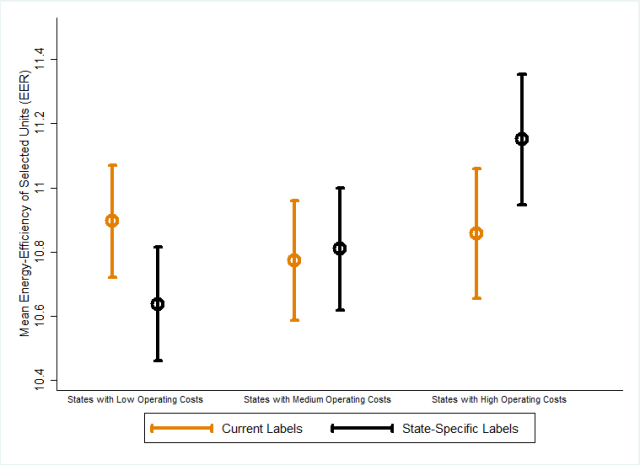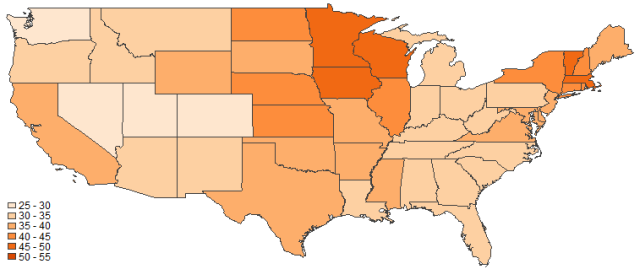Information provision is a key element of energy-efficiency policy. Just think of the ubiquitous yellow EnergyGuide labels, which are required by law to be displayed on all major appliances sold in the United States. This information is supposed to help consumers make better decisions. However, current labels report only very coarse information based on national average energy prices and national average usage of the appliance.
The information can be particularly misleading with air conditioners. Within the continental United States annual cooling hours range from 310 in Maine to 2,771 in Florida, almost a 9:1 ratio. Residential electricity prices vary too, so the overall variation in operating cost for an air conditioner ranges across states by more than an 11:1 ratio. This means that the current labels are providing highly inaccurate information for many consumers.
Annual Cooling Hours by State
In a new EI@Haas Working Paper, available here, Gib Metcalf and I conduct an online experiment to measure the potential benefits from providing more accurate information. The control group was shown the current labels, while the treatment group was shown labels with state-specific information. For example, the label on the right below is for Iowa, a state with below average electricity prices and usage. Both groups were then asked to make hypothetical choices between air conditioners with different purchase prices and levels of energy-efficiency.Â
       Current Label                      State-Specific Label (Iowa)
We find that when presented with more accurate information, the average energy-efficiency of selected air conditioners stays about the same, but the allocation is much better. That is, consumers facing low expected operating costs invest less in energy-efficiency, while consumers facing high expected operating costs invest more. The figure below shows this graphically. The circles show the mean for each group and the range indicates the 95th percentile confidence interval.
The implied aggregate savings are substantial. We find that state-specific labels decrease lifetime cost by an average of $10 per purchase. Last year 4.4 million room air conditioners were purchased in the United States, so this is $44 million in annual savings.
We argue that this exceeds any reasonable estimate of the cost of implementing better labels. The Federal Trade Commission (FTC) already maintains label templates that manufacturers can download. Instead of one template per appliance, the FTC would provide 50 different templates, one for each state, accessible through a drop-down menu. Perhaps at the same time the FTC could automate the simple calculation required to fill in estimated yearly energy cost. All of this could be done at low cost, and be done not only for room air conditioners but for other appliances too.
Our results are consistent with an emerging view of consumers as “rationally inattentive†when it comes to making energy-related decisions (Sallee, forthcoming). When we ask them at the end of the experiment simple questions about the labels they demonstrate a remarkably low level of comprehension. Most do not know whether the labels they just saw were based on national or state energy prices, nor do they know how their state’s energy prices compare to the national average.
Daniel Kahneman refers to this kind of decision making in his book as WYSIATI, “What you see is all there is.†The content of the labels changes decisions, so it is not that people are ignoring this information completely. But they are not exerting the additional effort that would be required to understand what this information means or to spontaneously transform the information to take local conditions into account.
You see this not only in our experiment, but in actual choices as well. If choices were being made efficiently, you would expect to see consumers throughout the South buying energy-efficient air conditioners.  Instead, the highest levels of adoption of Energy Star air conditioners are actually in the Northeast and Midwest.
Share of New Air Conditioners Sold that are Energy Star
This suggests that other factors like political ideology may be important. But it also provides further evidence that the current labels are not working as well as they could. It  is not enough to simply say, as the label does, that “Your cost will depend on your utility rates and use.† We need to provide better information to help consumers connect the dots.

Authored by:
Lucas Davis
Lucas Davis is an Associate Professor of Economic Analysis and Policy at the Haas School of Business. He received a BA from Amherst College in 1996 and a PhD in Economics from the University of Wisconsin in 2005. Prior to joining Haas in 2009, he was an assistant professor of Economics at the University of Michigan. His research focuses primarily on energy and environmental markets, and in ...




No comments:
Post a Comment